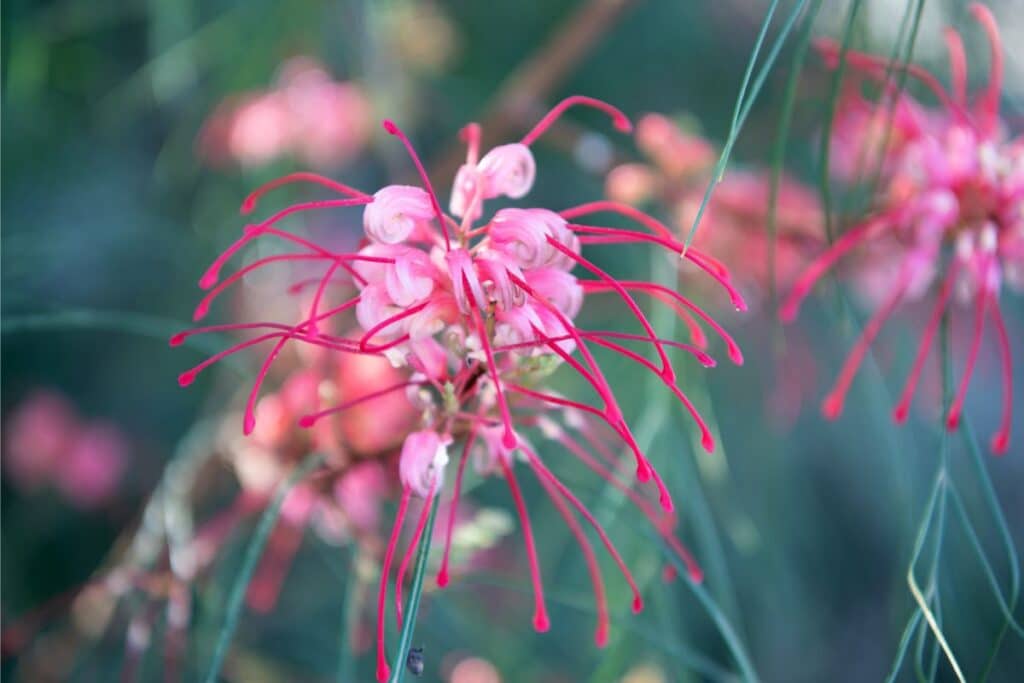Have you ever wondered what spider lilies represent? Wonder no more! In this blog post, we’ll explore the meaning and symbolism of spider lilies.
Native to Asia and parts of the Pacific Islands, spider lilies, Lycoris radiata, are a type of flower that is commonly associated with funerals and death.
This is because the flowers are used in funeral wreaths and bouquets. Spider lilies typically bloom in the fall, around the same time that leaves begin to fall from trees. The flowers are relatively short-lived, which also contributes to their symbolic association with death and immortality.
Despite their morbid associations, spider lilies can also symbolize other things, such as new beginnings or transformation. This is because the flowers often bloom in places where nothing else is blooming.
For example, spider lilies might bloom in a forest clearing where there is little else growing. In this case, the spider lily can represent hope or new life springing forth in the midst of death and destruction.
Spider lilies are also associated with water, specifically dirty or stagnant water. This is because they often grow near ponds or marshes. In some cultures, spider lilies are seen as being able to purify dirty water. In others, they’re seen as being able to attract spirits from the other world.
Let’s take a closer look.
What is the Spider Lily Flower Meaning?
The most common meaning of the Spider Lily, Lycoris radiata, is death and rebirth. This is because the Higanbana blooms along the path that souls take when they are heading to nirvana.
In Japan, it is also said that the Spider Lily blooms near graves or abandoned children. This is because the soul of a mother who died in childbirth sometimes transforms into a red magic lily.
In Japan, there is a place called Kinchakuda Park that is dedicated as a tribute to these gorgeous flowers.
The Spider Lily is also a symbol of final goodbyes. This is because it is often given to people who are about to go on a long journey. Spider lily plants symbolize death and the cycle of rebirth. It is also said that when you give someone a spider lily, you are giving them permission to die.
What Does the White Spider Lily Symbolize?
In general, the white spider lily represents purity, innocence, and new beginnings. They can also be used to symbolize grief or mourning.
Spider lilies have been used in a variety of ways throughout history. In ancient times, they were often used in burial ceremonies. In Japan, spider lilies are known as hana no yuki onna, which means “snow woman.” This name comes from a Japanese folktale in which a woman turns into a spider lily after she dies from waiting for her husband to come home from war.
While the meaning of the white spider lily varies depending on culture and context, there are some general meanings that are associated with these flowers.
What Does the Golden Spider Lily Represent?
In China, the golden spider lily is known as the ‘flower of autumn.’ This is because they typically bloom later in the year, around September or October. They are also sometimes referred to as ‘floating lotuses’ due to their resemblance to lotus flowers. The Chinese believe that these flowers represent purity and spiritual cleansing. They are often used in religious ceremonies and funerals.
In Japan, the golden spider lily is known as the ‘corn lily.’ Its scientific name, Lycoris radiata, actually comes from the Latin word ‘radiatus,’ which means ‘spokes of a wheel.’ This is because the individual petals of the flower resemble the spokes of a wheel. The Japanese believe that this flower blooms in order to guide people’s souls to the afterlife.
What is the Red Spider Lily Meaning?
The Red Spider Lily, also known as the Hellflower or the Hurricane Lily, is a flower with a long and rich history.Native to Asia, the Red Spider Lily has been associated with many different things over the centuries, from death and destruction to hope and renewal. In spite of its dark reputation, the Red Spider Lily is a beautiful flower that has been cherished by cultures all over the world.
The Red Spider Lily is native to China, Japan, and Korea. It is a member of the family Amaryllidaceae and is closely related to the Resurrection Lily. The Red Spider Lily gets its name from its red flowers and long stamens, which are often shaped like spider webs. The flowers bloom in late summer or early autumn and can range in color from pale pink to deep red.
The Lycoris radiata plant grows best in humid areas and can be found in damp woods, marshes, and along riverbanks. In China, the Red Spider Lily is known as “the flower of death” because it often blooms in places where mass graves have been dug. This association with death and destruction is one of the things that the Red Spider Lily has come to symbolize.
In Japanese culture, the Red Spider Lily is known as “hakuba no tsuyu”, which means “white horse dew”. It is said that if you drink dew from a white horse’s mane, you will be able to see spirits. This connection to ghosts and spirits led to the Red Spider Lily being associated with both life and death in Japanese culture.
This flower is sometimes referred to as the Higanbana flower as well.
Similarly, in Korean culture, the Red Spider Lily is known as “duranjae”, which means “wilderness flower”. It is often found blooming in abandoned places or along roadsides.
Like in Japan, this led to the Red Spider Lily (or demon slayer) being seen as both a positive and negative symbol—on one hand, it was seen as a sign of hope for those who were lost or forgotten, but on the other hand, it was seen as a reminder of death and destruction.
What Does the Blue Spider Lily Symbolize?
The blue spider lily, Lycoris radiata, is a beautiful flower that is enjoyed by many people all over the world. This flower has many different meanings, which makes it a popular choice for tattoos, gifts, and other occasions.
This flower has many different meanings in different cultures. In China, the blue spider lily symbolizes death and mourning. This is because the flower often blooms in cemeteries and on gravesites. In Japanese culture, this flower is used to ward off evil spirits. In Korea, the blue spider lily symbolizes purity, innocence, and love. And in Taiwan, this flower symbolizes good luck and fortune.
What is the Orange Spider Lily Meaning?
One common meaning of the Orange Spider Lily is death and the afterlife. In Japan, they associate the flower with final good-byes, death, and farewell.
In contrast, the Chinese people have a brighter outlook as they find orange spider lilies as the symbol of good luck and fortune. It is also known as the flower of the misfortunate, portraying it as an embodiment of resilience and endurance.
The tropical Orange Spider Lily (Lycoris Radiata), also known as Higanbana in Japan, has a rich history, with its roots tracing back to ancient Japanese culture, where it was believed to protect against evil spirits. The unusual color of the spider lily has prompted many different symbolic meanings in various cultures.
What is the Yellow Spider Lilies’ Flower Meaning?
Yellow Spider Lilies (Lycoris Aurea) are exceptionally striking, also known as Golden Spider Lily – their yellow petals and unique shape mean they represent charm and allure.
They also symbolize happiness, particularly between two people in love. In Japanese, yellow spider lilies are known as Higanbana, where Higan means ‘the emotions one feels while crossing to the other side,’ and bana means flower. Therefore, these flowers represent both beauty and transience.
Some people even believed that the bright yellow flowers marked the bridge between the visible and the invisible worlds.
What is the Pink Spider Lily Flower Meaning?
The main meaning of the Pink Spider Lily is embodied in the beauty of life and a celebration of the cycle of life and rebirth.
They symbolize purity, healing and growth, and affection, making it an ideal gift for close friends, family members, and loved ones. In Higan Roku, a Japanese Buddhist text, the Pink Spider Lily signifies a nostalgic longing for a loved one.
The Pink Spider Lily (Lycoris Incarnata) is a beloved flower in many cultures around the world and is thought to bring joy and love to anyone who receives it.
This lovely flower is often given to people on special occasions such as weddings, birthdays, and Valentine’s Day.
What Does the Spider Lily Symbolize in Korea?
Lycoris radiata flowers are commonly found in Korea and have a history dating back to the Joseon dynasty. The scientific name for the spider lily is Coalhada lily (Lycoris radiata), and it is a member of the cluster amaryllis family. The Korean name for the flower is “dolityeom” which literally means “earth-tiger lily.”
It got this name because the plant blooms in late September or early October which is when the weather starts to cool down and the days become shorter.
Growing best in full sunlight, the appearance of Lycoris radiata offers a cheerfulness that can’t be overlooked – although its ultimate meaning and folklore have connections to a pretty sad memory.
The spider lily is significant in Korean culture because it is known as a flower of mourning. In Korea, white flowers symbolize death and are used at funerals. The spider lily’s meaning can be traced back to a story from the Joseon Dynasty about a young boy named Dal-Seong.
Dal-Seong was very filial and loved his widowed mother deeply. One day, while he was out looking for medicinal herbs, he ran into some bandits who stole his horse. To prevent them from getting away, Dal-Seong cut off one of his legs and gave it to the bandits as ransom for his horse. struck by his act of filial piety, the gods turned Dal-Seong into a spider lily so that he could be with his mother forever.
Since then, the spider lily has been associated with aspects of filial piety such as loyalty, devotion, and obedience. For this reason, they are often given as gifts to elders during Chuseok (Korea’s harvest festival) or Seollal (Korean New Year). The spider lily is also sometimes referred to as the “flower of loyalty” or “flower of devotion.”
What Does the Spider Lily Symbolize in Japan?
The spider lily is a popular flower in Japan that can be found in many gardens across the country. The spider lily symbolizes summer because it blooms during the hottest months of the year. It’s also seen as a metaphor for the transience of life because it only blooms for a short time before dying.
In some cases, spider lily stems can also be seen as a symbol of death. This is because the flower is associated with graveyards and funerals. The color of the spider lily can also have different meanings. White spider lilies are typically associated with purity, while red spider lilies are associated with passion or love.
Aside from their deep symbolism in Korea and Japan, spider lilies also have strong connections to Buddhists and Buddhist scriptures in places like Nepal.
Are Spider Lilies Bad Luck?
Throughout history, people have associated certain flowers with good or bad luck. In some cultures, it is considered bad luck to give someone a gift of lilies, as they are often associated with funeral homes and sadness. Spider lilies, in particular, are said to be especially unlucky. But why? Let’s take a closer look at the origins of this belief.
The belief that spider lilies are bad luck likely dates back to the plant’s native country of Japan. In Japanese culture, the spider lily is known as “higanbana,” which literally translates to “equinox flower.”
The name comes from the fact that the flowers usually bloom around the time of the autumn equinox, which is a time when the boundaries between the worlds of the living and the dead are said to be blurred. As a result, spider lilies are often associated with death and funerals.
This belief may also be related to the plant’s toxic nature. All parts of the spider lily plant are poisonous, and ingesting even a small amount of its poison can lead to nausea, vomiting, diarrhea, and seizures. Given the plant’s association with death and its poisonous nature, it’s not surprising that some people believe spider lilies are bad luck.
Whether or not you believe spider lilies are bad luck, there’s no denying that they’re beautiful flowers and have an ultimately positive nature. If you do decide to grow them in your garden, just be sure to keep them away from curious pets and small children who might try to eat them!
When is the Best Time to Give a Spider Lily?
Now that you know the spider lily meaning, when should you give one?
The autumnal equinox is the perfect time to give a spider lily. In Japan, this holiday is known as Higan and it occurs on either September 23rd or 24th. Higan means “the other shore” and it refers to the afterlife. During Higan, people visit the graves of their ancestors and pay their respects. Spider lilies are often given as gifts during this time because they symbolize rebirth and renewal.
Another ideal time to give a spider lily is All Souls’ Day, which falls on November 2nd. This Christian holiday honors the dead and is also known as the Day of the Dead in some cultures. Giving someone a spider lily on All Souls’ Day is a way of showing that you will never forget them and that they will always be in your thoughts.
Although they are most commonly associated with autumn holidays, spider lilies can be given for any occasion. If you know someone who is going through a tough time, a spider lily can be a reminder that better days are ahead. They make wonderful get well soon gifts and sympathy gifts.
You can also give them to celebrate a new beginning or show your appreciation for someone special in your life. No matter what the occasion may be, a spider lily is always appreciated!
Spider Lilies are beautiful flowers that have a long history of symbolism and tradition attached to them. Though they are commonly associated with death, they can also represent hope. Red, gold, white, and blue aren’t your only choices of colors for this flowering plant, either. You can brighten up someone’s day with a yellow spider lily, orange lily, or other breathtaking flower clusters.
No matter what time of year it is, giving someone a spider lily is sure to put a smile on their face. These flowers are not only beautiful but also filled with meaning. Whether you give it by itself or in a bouquet filled with other meaningful flowers, like wisteria or chrysanthemums, it’s sure to make its mark and serve as inspiration for your loved ones.
If you are looking for the perfect gift for an upcoming holiday or just want to show someone how much you care, give them a spider lily and let them know that you are thinking of them.
Uses of Spider Lilies
Spider Lilies have a long history of being used in traditional medicine. In China, for example, the flowers were used to treat fevers and headaches. The petals were also sometimes used as a bandage for open wounds.
In Korea, a tea made from spider lily bulbs was often given to women after they gave birth. This was thought to help them recover more quickly and prevent infection.
The bulbs of spider lilies were also used to make a type of fabric dye in Ancient Japan. This dye was used to make kimonos and other traditional Japanese garments. The petals of the spider lily were also sometimes used as decoration on these garments.
This is a perennial plant that you will hear referred to by many names, including flowers of the heavens, the ghost flower, manjushage, surprise lilies, and more.
No matter what you call them, these flowers’ ability to resist pests, grow easily in a variety of conditions, and produce breathtaking blooms and foliage makes them one of the best options for a bouquet.
Final Thoughts on the Spider Lily Meaning
The Spider Lily is a beautiful flower that has been celebrated for centuries for its symbolic significance. It holds a range of meanings, from death and rebirth to good luck and fertility. Its unique appearance and rich cultural history make it a popular choice for gardeners and gift-givers alike.
The spider lily is a true marvel of nature that continues to inspire us all today!
*image by stetsik/depositphotos







